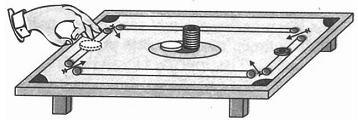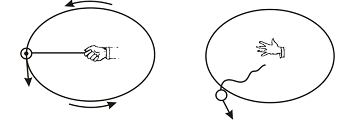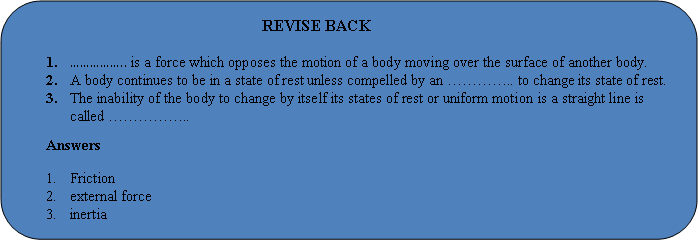
INERTIA
Force Laws of Motion of Class 9
DESCRIPTION:
If follows from first law of motion that is absence of any eternal force, a body continues to be in its state of rest or of uniform motion along a straight line. In other words, the body cannot change by itself its position of rest or of uniform motion.
The inability of the body to change by itself its states of rest or uniform motion is a straight line is called inertia. Newton’s’ first law of motion is also called law of inertia.
(a) Inertia Depends upon Mass : L
We know that it is difficult to move a heavier body than the lighter one. Similarly it is difficult to stop a moving heavier body that a lighter body moving with the same velocity. Thus, we conclude that mass of the body is the measure of inertia, more the mass, more the inertia.
Types of Inertia
Inertia can be divided into three types:
- Inertia of rest
- Inertia of motion
- Inertia of direction
Inertia of Rest: The tendency of a body to oppose any change in its state of rest is known as inertia of rest. Examples of inertia of rest are :
- When a bus suddenly starts moving forward, the passengers in the bus fall backward. This is because the lower part of the bodies of the passengers being in contact with the floor of the bus come in motion along with the bus. On the other hand, the upper part of their bodies remain at rest due to inertia of rest. Hence the passengers fall backward.
- The carpet is beaten with a stick to remove the dust particles. When the carpet is beaten with a stick, the fibres of the carpet come in motion and hence move forward. On the other hand, the dust particles remain at rest due to inertia of rest. Therefore, they fall down.

- Place a fifty paise coin on a piece of a card-board covering the glass. Strike the card board with a finger. The card board flies away and the coin falls into the glass due to inertia of rest.
- When a tree is vigorously shaken, some of the fruits fall from the tree. When a tree is vigorously shaken, the branches of the tree come in motion but the fruits tend to continue in their state of rest due to inertia of rest. As a result of this, fruits get separated from the branches of the tree.
- A pile of similar carom coins on a table, as shown in figure, is hit at the bottom of the pile using another carom coin or the striker. If the hit is strong enough, the bottom coin moves out quickly. Once the lowest coin is removed, the inertia of the other coins makes them ‘fall’ vertically on the table.

Only the carom coin at the bottom of a pile is removed
when a fast moving carom coin (or striker) hits it
Inertia of Motion: The tendency of a body to oppose any change in its state of uniform motion is known as inertia of motion. Examples of inertia of motion are :
- The passengers fall forward when a fast moving bus stops suddenly. This is because the lower part of the bodies of the passengers comes to rest as soon as the bus stops. But the upper parts of their bodies continue to move forward due to inertia of motion.
- A person falls forward while getting down from a moving bus or train. This is because as the foot of the person touches the ground, the lower part of his body comes to rest while the upper part of his body remains in motion due to inertia of motion.
- A luggage is usually tied with a rope on the roof of buses. When a moving bus suddenly stops, the luggage on its roof tends to continue in the state of motion due to inertia of motion. Hence the luggage fall down from the roof of the bus. Similarly, when a bus suddenly starts, the luggage on the roof of the bus tends to continue in the state of rest and hence fall down from the roof of the bus. Thus, to avoid the falling of the luggage, it is tied with a rope on the roof of a bus.
Inertia of Direction: The tendency of a body to oppose any change in its direction of motion is known as inertia of direction. Examples of inertia of direction are :
- When a fast moving bus negotiates a curve on the road, passengers fall towards the centre of the curved road. This is due to the tendency of the passengers to continue to move in a straight line.
- The sparks produced during sharpening of a knife against a grinding wheel leave the rim of the wheel tangentially. This is because of the inertia of direction.
- A stone tied to a string is whirling in a horizontal circle. If the string breaks, the stone flies away tangentially. The stone moving in a circular path has the direction of motion along the tangent at any point of the circle. The pull of hand keeps it in a circular path. As soon as the string breaks, the force acting on the string ceases and the stone continues to move along the tangent of the point of the circle due to inertia of direction.

- An umbrella protects us from rain. It is based on the property of inertia of direction. The rain drops falling vertically cannot change their direction of motion on their own and wet us, with umbrella on, they move along the surface of umbrella and fall down.
DEFINITION OF FORCE FROM FIRST LAW OF MOTION:
According to first law of motion, if there is no force, there is no change in state of rest or of uniform motion. In other words, if a force is applied, it may change the state of rest or of uniform motion. If the force is not sufficient, it may not produce a change but only try to do so.
Hence force is that which changes or tries to change the state of rest or of uniform motion of a body in straight line.







